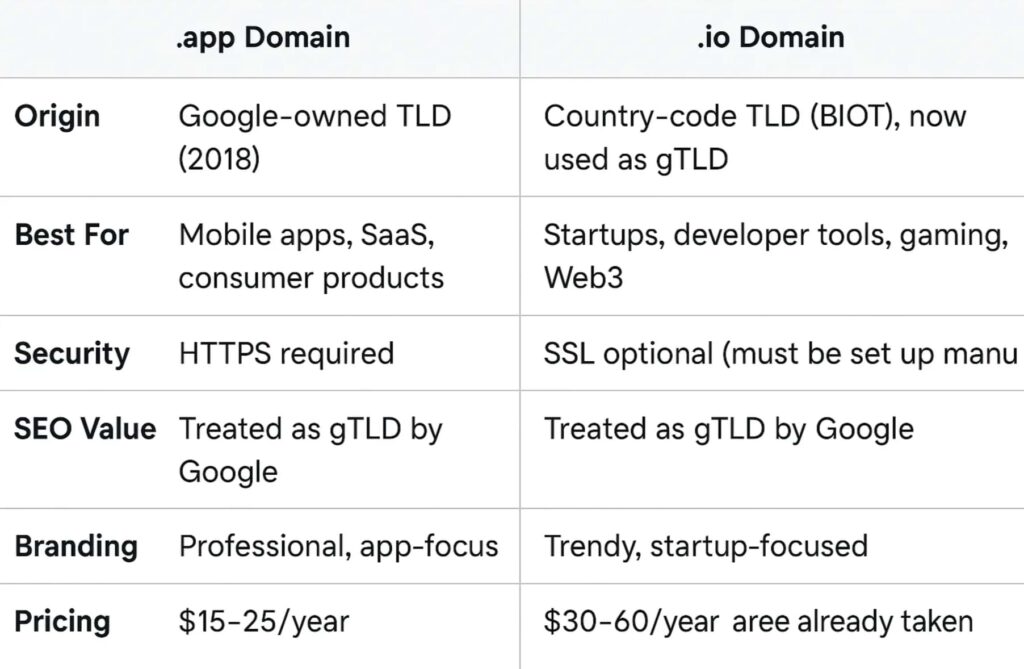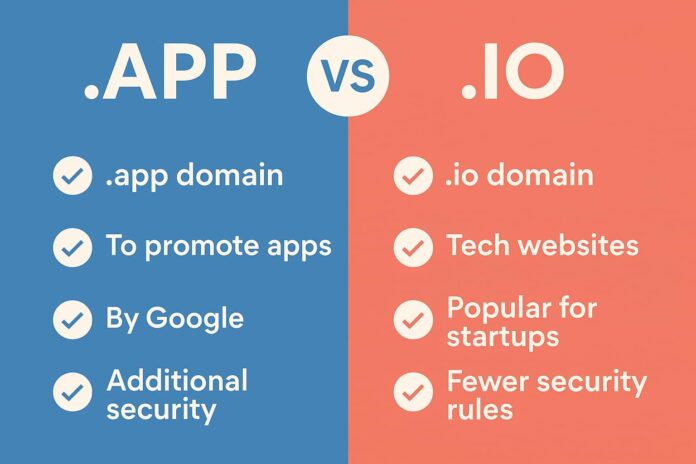Choosing the right domain name extension is one of the most important decisions for any startup, SaaS business, or mobile app. Today, two extensions dominate the tech space: .app and .io. Both are popular, both are SEO-friendly, and both carry unique branding advantages. But when it comes to App vs IO, which one should you choose?
In this guide, we’ll compare .app vs .io domains, breaking down their history, advantages, SEO value, and real-world use cases—so you can confidently pick the best domain for your business in 2025.
What is a .app Domain?
The The The The The .app domain is a top-level domain (TLD) owned by Google, launched in 2018. It was created to give developers, SaaS companies, and mobile app creators a clear way to brand their products online.
Key Features of .app
-
✅ Google-backed domain, highly trustworthy.
-
✅ Mandatory HTTPS encryption (all
.appsites require SSL). -
✅ Affordable pricing (typically $15–25/year).
-
✅ Instantly signals that your product is an app or SaaS tool.
Example: Popular products like notion.app and todoist.app use .app for clean, modern branding.
What is a .io Domain?
The The The The The .io domain was originally the country code for the British Indian Ocean Territory, but it has since been adopted by the tech and startup community. Today, it .io is widely recognized as a tech-first extension that appeals to developers, investors, and early adopters.
Key Features of .io
-
✅ Associated with innovation, startups, and Web3 projects.
-
✅ Treated as a generic top-level domain (gTLD) by Google.
-
✅ Premium feel but comes with a higher price tag (~$30–60/year).
-
✅ Popular in developer tools, gaming, and blockchain industries.
Example: Platforms like github.io and opensea.io have cemented .io as the go-to domain for cutting-edge tech.
App vs IO: Side-by-Side Comparison

SEO Impact: Does .app or .io Rank Better?
From an SEO perspective, both .app and .io are treated as generic top-level domains. That means:
-
No ranking disadvantage compared to
.comor.org. -
Google ranks sites based on content, backlinks, Core Web Vitals, and user trust, not just the extension.
SEO Pros of .app
-
Built-in HTTPS increases security and trust, which are SEO ranking signals.
-
Strong branding if your product is app-focused, leading to better click-through rates (CTR).
SEO Pros of .io
-
Recognized by tech-savvy audiences (developers, VCs, blockchain users).
-
Can attract niche authority in startup and developer ecosystems.
👉 Bottom line: Neither extension hurts SEO. Your ranking will depend more on content quality and backlinks than whether you choose .app or .io.
Branding & User Perception
Your domain name isn’t just about SEO—it’s about brand identity.
-
.app domains signal trust, security, and professionalism. Perfect for SaaS companies or mobile apps targeting a broad consumer base.
-
.io domains feel innovative, startup-friendly, and community-driven. They resonate with early adopters, developers, and investors.
Example:
-
If you’re launching a task management app, it
taskflow.appfeels polished. -
If you’re building a blockchain SDK,
chainkit.iofit its better.
Security Considerations
-
.app Domains: Automatically require HTTPS due to inclusion in Google’s HSTS preload list. This means stronger protection for users.
-
.io Domains: Don’t enforce HTTPS by default, but SSL can be added manually.
👉 If security and consumer trust are top priorities, it .app is the safer choice.
Pricing & Availability
-
.app: Lower cost (~$15–25/year). More domain names are still available since it’s newer.
-
.io: Higher cost (~$30–60/year). Many premium names are already taken.
If budget and availability matter, it .app offers more flexibility.
Which One Should You Choose?
✅ Choose .app if:
-
You’re building a consumer-facing app or SaaS.
-
You want Google-backed trust and mandatory HTTPS.
-
You need a budget-friendly option.
✅ Choose .io if:
-
You’re targeting developers, investors, or Web3 users.
-
You want to stand out in the startup ecosystem.
-
You don’t mind paying extra for a trendy domain.
FAQs
Q1. Is .app better than .io for SEO?
No. Both are treated equally by Google. Rankings depend on content, backlinks, and site performance.
Q2. Why is .io popular with startups?
It’s short, modern, and widely recognized in the tech and VC ecosystem, giving it a “startup culture” image.
Q3. Is .app safe?
Yes,.app is one of the most secure TLDs since HTTPS is mandatory.
Q4. Which one is cheaper?.app is usually cheaper ($15–25/year) compared to $30–60/year)..io (
Key Takeaways
- Both .app and .io are SEO-friendly, secure, and modern extensions.
- .app = best for SaaS, mobile apps, and consumer-focused businesses.
- .io = best for startups, developer tools, and Web3 platforms.
- Pricing and branding should guide your decision more than SEO.
Final Verdict:
If your business revolves around an application or SaaS product, go for .app. If you’re targeting tech-savvy users, developers, or investors, it .io will give your brand a cutting-edge identity.








![Best Samsung 5G Phones Under ₹30,000 in India – Latest Models & Reviews[May, 2025] Samsung A35 5g](https://appeio.com/wp-content/uploads/2025/02/Samsung-smartphones-under-30k-356x220.webp)
![Top 4 Best Samsung Phones under 40000 [April,2025] Top 4 Best Samsung Phones under 40000](https://appeio.com/wp-content/uploads/2021/05/Top-4-Best-Samsung-Phones-under-40000.jpg)




